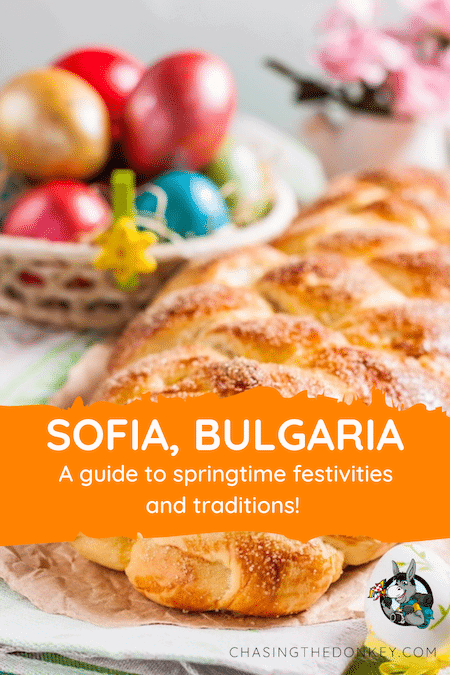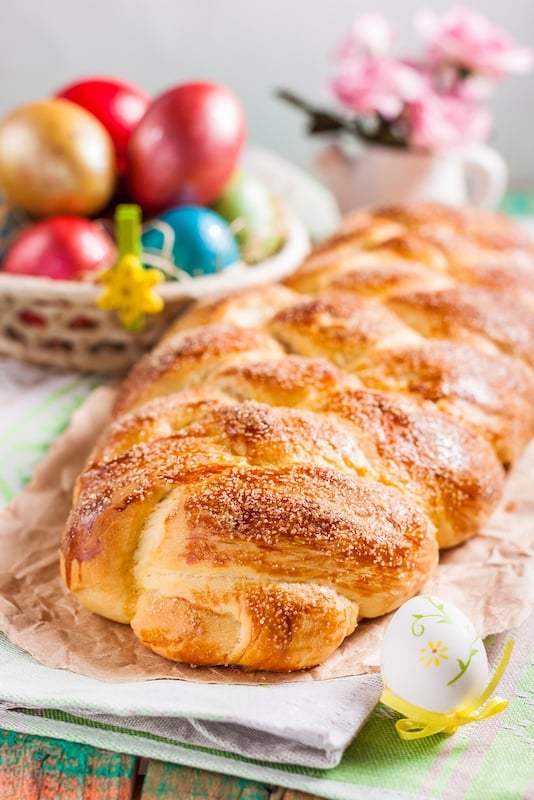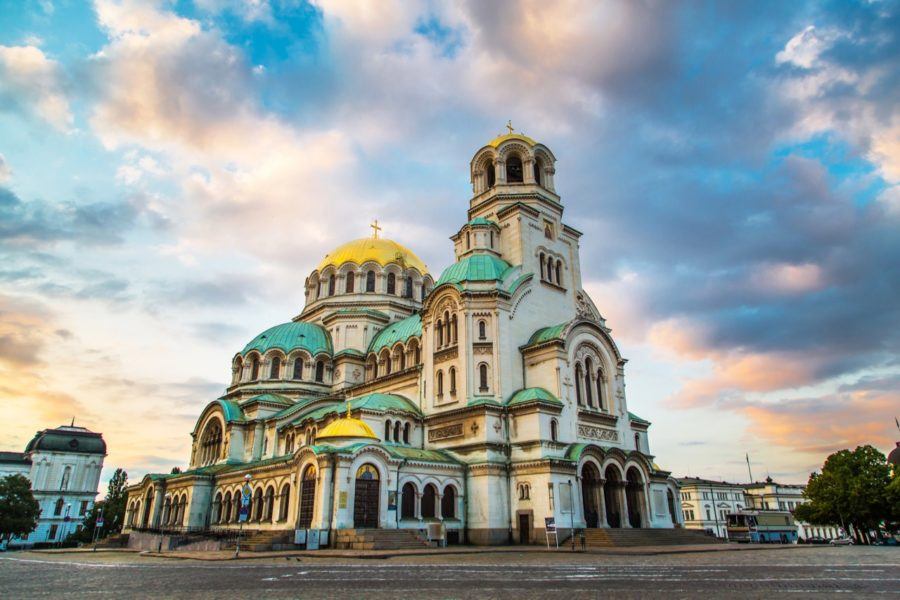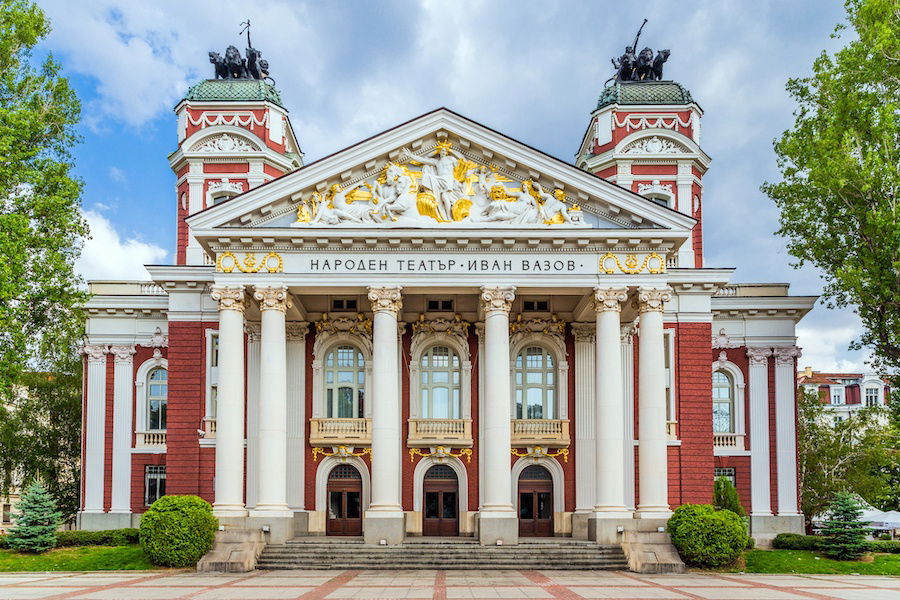Sofia in the spring is more than surprising; the Easter traditions and May festivities set against a cityscape of trees in blossom make this a special time to visit the Bulgarian capital.

The weather swings madly from one day to another, adding even more emotion to the overall fun of springtime in Sofia… imagine a stroll through the park in crisp sunshine, across city squares and past monuments, church domes glinting in the sunlight – and wake up next morning to a snow scene wonderland of white-carpeted streets and frosted rooftops, and retrace your steps through the old quarters. The contrast is magic, quite unbelievable!
Of course, Bulgaria in springtime has much more to offer than sunbeams and snowflakes – ballet dancing, the opera, classical concerts, and Easter traditions, for example.
Skip Ahead To My Advice Here!
Martenitsi

Martenitsi is a symbol of spring in Bulgaria. Basically made of twisted red and white twine, this good luck charm is given to friends or loved ones on the first day of March.
The traditional Martenitsi is a brooch in the form of 2 dolls, but nowadays, it’s more popular to wear a simple thread and bead bracelet. It’s an incredibly old custom to herald the spring. If you’re given a Martenitsi, wear it until you see the first tree blossom, then tie it to the branch for luck and good health.
Easter In Sofia
Bulgaria still uses the Julian calendar, and Easter falls late in the Orthodox Church countries compared to other Christian societies. ‘Pashkët Orthodoske’ depends on Passover, so 2020 holiday dates are as follows: April 17 Orthodox Good Friday, April 18 Holy Saturday, April 19 Easter Day, and April 20 Easter Monday.
Visiting Sofia during the Easter celebrations is quite a contrast to city folk going home to village life in rural Bulgaria over the holidays. It leaves the hectic streets quieter than usual; meanwhile, Sofia’s grand temples hold special services that are the focus of attention. Join in the traditions, buy a painted egg, or make your own, eat Kozunak sweetbread for breakfast on Easter Sunday or treat yourself to some Kurabiiki sugar cookies.
Bulgarian Easter Traditions

- Kozunak Easter Bread: Kozunak is sweet plaited bread traditionally baked at home on Maundy Thursday. Make the dough with flour, yeast, eggs, sugar, butter, and milk, stir in lemon and vanilla essence to flavor and finally add chopped nuts and rum-soaked raisins before baking.
- Colored Easter Eggs: Maundy Thursday, it’s typical to make colored eggs. Not the foil-wrapped chocolate ones we know; these are fresh! First hardboiled, then dipped into bold-colored dyes, by tradition, the first egg is painted bright red to bring good health. The real fun starts on Easter Sunday morning with an ‘egg fight,’ not as messy as it sounds; this is a sparring contest where you hold your favorite egg and press it hard against a competitor’s until one of the shells crack.
- Kurabiiki Sugar Biscuits: These sweet, crunchy cookies are made of flour, honey, egg yolk, and butter mix, rolled into balls, sprinkled with coarse sugar, and then baked. A favorite treat on Holy Sunday, everybody loves these delicious bickies!
- Orthodox Easter Midnight Mass: Churches throughout Bulgaria celebrate Holy Saturday Midnight Mass. In the heart of Sofia, Saint Alexander Nevski Cathedral holds an extraordinary service (starts at 11 pm on Holy Saturday), the most important religious, cultural event in the whole country. Meanwhile, similar Midnight Masses are held in Orthodox churches across the city to commemorate the Resurrection of Christ. Ceremonies in these ancient temples are extremely atmospheric, come along with a candle and join in the ritual performed for centuries… a priest in full regalia will light each candle as the congregation slowly circles the nave three times in the candlelight and smoldering incense. St Sofia Church is only 2 minutes from the Cathedral and provides a genuine chance to witness these olden rites.
Brands We Use And Trust
St Alexandar Nevski Cathedral

Alexandar Nevski Cathedral (1882) is Bulgaria’s most illustrious site. A monumental Orthodox Basilica with an authentic gold-plated central dome and bell tower, surrounded by an array of smaller green domes, this architectural wonder sits in the middle of Alexander Nevsky Square across from the Bulgarian National Parliament. The relics of Saint Alexander Nevsky rest in the temple’s ornate interior, which is lavishly decorated with icons and murals made with exquisite mosaics brought over from Venice, Italy. The Italian influence is evident in the Cathedral’s Neo-Byzantine design and the distinctive marbles which embellish the inside.
Alexander Nevsky Square. Open daily from 7 am to 7 pm. Entrance free of charge.
St Sofia Church
St. Sofia Church (527-565) is built on an ancient necropolis making it one of the oldest and best-loved churches in Sofia. Subsequently restored over the ages, the simplicity of the red brick façade and dark hushed chapel exudes an aura of timeless devotion. Outside, an eternal flame burns as a Monument to the Unknown Soldier, while the enigmatic lion sculpture (the symbol of Bulgaria) quietly looks on.
2 Paris Street. Open March–September 7 am to 7 pm; October–February 7 am to 6 pm.
Entrance into St. Sofia Church is free of charge; Necropolis Museum costs 6 BGN.
Bulgarian National Holidays in May
May Day
May 1st is Labour Day and a National Holiday throughout Bulgaria when shops and banks will be closed. *As the date falls on a Sunday this year (2020), Monday, May 2nd, will be taken as a holiday in lieu.
St. George’s Day
The 6th of May is St. George’s Day, a National Holiday to commemorate its Patron Saint. Also, on the Bulgarian Armed Forces day, there are formal military parades through the city center to mark the date. Food-wise the custom is to eat a copious meal of spit-roasted lamb with a glass of red wine to celebrate a family gathering.
St. Cyril’s And St. Methodius’ Day
On the 24th of May, Bulgarians celebrate ‘Cyrillic Alphabet & Slavonic Literature Day.’ This National Holiday is a favorite with students and a highlight on the academic calendar. One of the main attractions is watching the traditional street procession, which starts at the Sofia Archaeological Museum and ends with the statues of St Methodius and St Cyril outside the National Library. Literature lovers should head over to the National Palace of Culture to see the famous Spring Book Fair. A special mass in Alexander Nevski Cathedral is another feature of this fascinating day.
Sofia Cultural Events And Venues

National Opera and Ballet
The Bulgarian capital has a rich cultural background, a love of literature, the arts, classical music, and ballet. The National Opera and Ballet House is an imposing white stone building with an ornate column façade, which was originally designed in 1921 and constructed for the most part between 1947 and 1953. Check out the extensive program of events on the official website and enjoy an evening of authentically glamorous entertainment.
30 Dondukov Blvd. Website: www.operasofia.bg/en
Sofia Music Weeks

‘Sofia Music Weeks’ is an enormously prestigious international festival which has been taking place since 1970. Throughout the last week of May, right up to the middle of June, classical music, ballet, and opera performances are held in Sofia’s top venues, such as the Bulgaria Concert Hall, the National Gallery of Fine Arts, and the National Palace of Culture. World acclaimed conductors and symphony orchestras, quartets and chamber ensembles, choirs and opera singers, ballet dancers, and musicians come together for three weeks of concerts and cultural heaven.
National Art Gallery
The National Art Gallery is housed in the monumental building on ‘Battenburg Square.’ Originally the Tsar of Bulgaria’s Royal Palace, it has an ornate distinctively chateau style design (1880). More than 4000 medieval paintings and an important collection of contemporary Bulgarian works of art are on display inside.
Formerly known as ‘Tsar’s Square,’ the large public space in front of the gallery is used as a venue for open-air concerts and St George’s Day military parade.
Knyaz Alexander 1 Square (Battenburg Square). Open Tuesday-Sunday: 10 am to 6 pm.
Closed Mondays, official Bulgarian holidays, Christmas, New Year’s Day, and Easter.
Entry tickets cost 6 BGN; students or pensioners only 3 BGN; Thursday’s special price of 2 BGN.
Ivan Vazov National Theatre
Ivan Vazov National Theatre was first built in 1906, repaired at later dates after a fire and air raid damage, and more recently reconstructed (1976) keeping to the original design. The symmetrical neoclassical architecture incorporates brickwork detail and a white column entrance flanked by a tower on either side.
5 Dyakon Ignatiy Street.
Ticket office opens: Monday-Friday 9.30am to 7.30pm; Saturday & Sunday 11.30am to 7.30pm.
Gardens and Parks in Springtime Sofia in March will mean changeable weather, oscillating from cool and sunny to chill snow overnight. Milder April sees green leaves and blossoms on the trees while the city flowerbeds bloom to their full glory in the warmth of the temperate May days.
City Garden
The National Art Gallery is set beside City Garden, which was designed almost 150 years ago in 1872. This is a favorite place for playing chess, and on most days, you’ll come across the typical scene of pensioners having a game on one of the park benches in front of Sofia’s National Theatre.
Borisova Gradina Garden
Boris’s Garden is a few minutes’ walk south of Sofia University (Metro Station on Line 1) towards Orlov Most Square. Created in 1884, this is one of Sofia’s oldest and largest parks, a green lung of botanical trees and flowerbeds, an exotic lily pond, an artificial leisure lake, jogging tracks, paths, and cycle lanes. Lake Ariana is near the park entrance close to the iconic Eagle’s Bridge. This popular boating lake freezes over in the winter to become an outdoor ice-skating rink.
The National Stadium, the home ground of the Bulgarian football team, is in the same vicinity. A venue for international sporting events, cup finals, and athletic championships, various festivals and concerts are held here throughout the year.


Sofia looks really gorgeous in spring, almost fairy-tale like with the flowers blooming and sound of classical music permeating through the air!